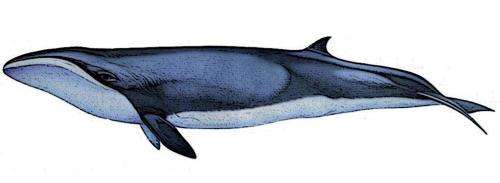December 21, 2012 report
Elusive pygmy right whale found to be member of long thought extinct group

(Phys.org)—Researchers in New Zealand have found that the pygmy right whale (Caperea marginata) is not a right whale at all but is instead a member of the cetotheres family of baleen whales, which until now have been believed to be extinct. The team reports on its finding in a paper they've had published in the Proceedings of the Royal Society B.
Pygmy right whales live in the southern hemispheric oceans far from land and are rarely seen, thus compared to other whales, very little is known about them. They're also small, growing to a length of just 21 feet and have a very unique arched snout and mouth; appearing as if an upside down grin. Scientists had previously thought the whale was a member of the humpback or bowhead family, as its appearance more resembled those than other baleens.
Helping to clarify things, was a pygmy right whale carcass found on a beach in New Zealand in 2002. This new research is based on those remains and on the limited number of other bone samples that have been obtained. A DNA analysis made along with head measurements showed that the whale is in fact a member of the Cetotheriidae family of whales which scientists believed had been extinct for perhaps 2 million years. Because of that the researchers refer to the pygmy right whale as a "living fossil."
The whale is the smallest of the baleen family, and the most reclusive. So much so that scientists know very little about its habits such as what they eat, mate, how they behave etc. and can't even guess as to how many of them there are alive today. The DNA analysis revealed that the whales evolved approximately nine million years ago, during a time when several other species of the family existed. It's not known why the others died out while the pygmy was able to survive, but its existence today offers scientists a unique opportunity to study an animal that exists today much as did it and its relatives millions of years ago – if they can find some live specimens to study, of course.
More information: The pygmy right whale Caperea marginata: the last of the cetotheres, Published online December 19, 2012. doi: 10.1098/rspb.2012.2645
Abstract
The pygmy right whale, Caperea marginata, is the most enigmatic of the living baleen whales (Mysticeti). Its highly disparate morphology and the virtual absence of a described fossil record have made it extremely difficult to place Caperea into a broader evolutionary context, and molecular and morphological studies have frequently contradicted each other as to the origins and phylogenetic relationships of the species. Our study of a wealth of material from New Zealand collections, representing a wide range of ontogenetic stages, has identified several new features previously unreported in Caperea, which suggest that the pygmy right whale may be the last survivor of the supposedly extinct family Cetotheriidae. This hypothesis is corroborated by both morphology-based and total evidence cladistic analyses, including 166 morphological characters and 23 taxa, representing all the living and extinct families of toothless baleen whales. Our results allow us to formally refer Caperea to Cetotheriidae, thus resurrecting the latter from extinction and helping to clarify the origins of a long-problematic living species.
Journal information: Proceedings of the Royal Society B
© 2012 Phys.org



















